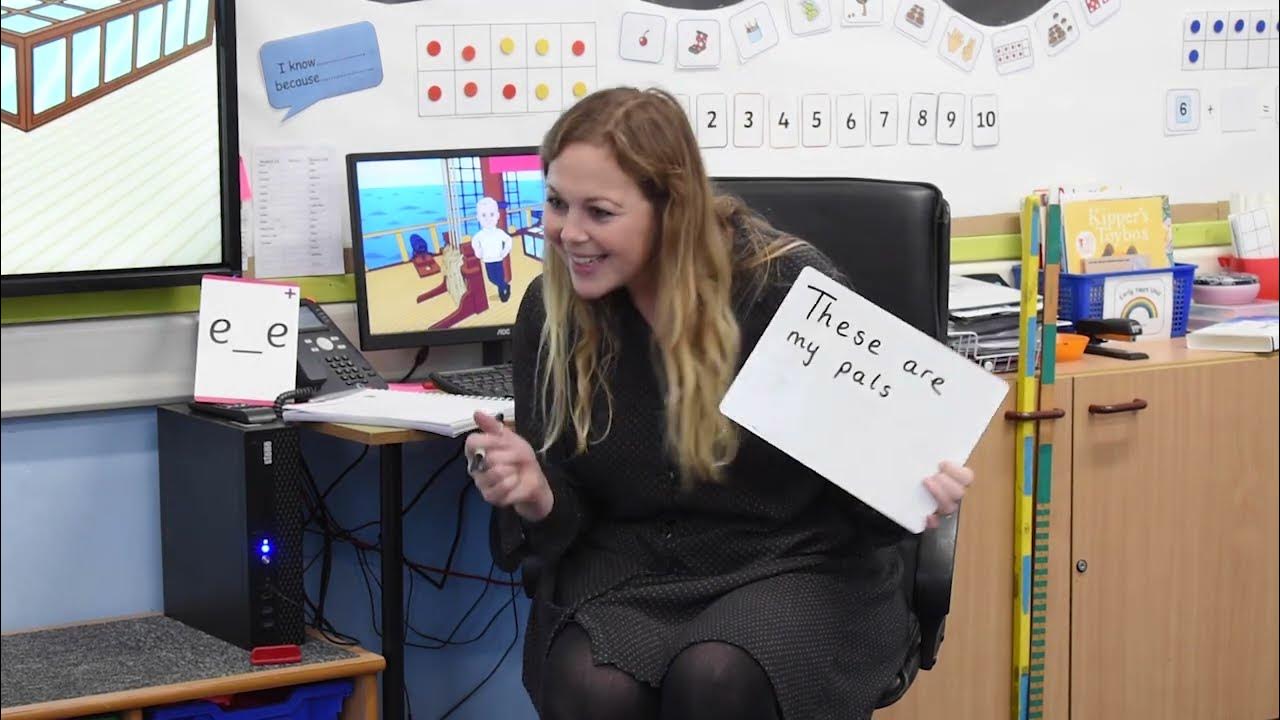UFLI Foundations: Model Lesson Day 1 (Full Length)
Summary
TLDRThis educational lesson focuses on teaching students the different ways to spell the long 'e' sound through interactive drills and activities. The lesson covers various vowel teams like 'ee', 'ea', and 'ey', with an emphasis on auditory blending, segmenting, and peer checking. Teachers use engaging techniques such as jazz hands, visual cues, and hands-on exercises to reinforce learning. Students actively participate in spelling, segmenting, and correcting mistakes, while also practicing self-assessment. The lesson aims to build foundational spelling skills, emphasizing the importance of accuracy and consistency in applying spelling rules.
Takeaways
- 😀 The lesson focuses on teaching students to read and spell using different vowel combinations that create the long 'e' sound, such as ee, ea, and y.
- 😀 The importance of actively listening and following directions is emphasized to enhance reading and spelling skills.
- 😀 The script includes regular peer checking and self-assessment, encouraging students to monitor their own progress.
- 😀 The teacher integrates movement with learning, using actions like jazz hands and hand motions to keep students engaged and motivated.
- 😀 Various vowel teams (like ee, ea, and ey) are introduced, with explanations on when and where to use them in words.
- 😀 Students practice blending and segmenting sounds in words such as 'heat,' 'beet,' and 'greet' to strengthen phonemic awareness.
- 😀 A significant focus is placed on teaching students how to spell different sounds and identify their corresponding letters, such as 'e' spelled with 'ea' or 'ey'.
- 😀 The teacher uses visual drills and auditory drills to reinforce the sounds and their spellings, helping students memorize the patterns.
- 😀 The importance of correct letter formation is addressed, with guidance on how to write letters like 'e,' 'a,' and 'y' using the correct stroke technique.
- 😀 A final review encourages students to spell and read words aloud, such as 'eat,' 'need,' and 'kidney,' ensuring they understand the concepts of syllables and vowel patterns.
Q & A
What is the main spelling rule discussed in the script?
-The main spelling rule discussed is for the long 'e' sound, using various vowel teams like 'ee', 'ea', 'ey', 'e', and 'y'.
How is the long 'e' sound typically spelled according to the lesson?
-The long 'e' sound is spelled using 'ee', 'ea', 'ey', 'e', and 'y'. Examples include 'Eagle', 'tree', 'need', 'eat', and 'monkey'.
What is the importance of phonemic awareness in this lesson?
-Phonemic awareness is essential as students blend, segment, and manipulate sounds to improve their reading and spelling skills.
How does the teacher emphasize the 'e' sound in the lesson?
-The teacher emphasizes the 'e' sound through activities like blending, segmenting, visual drills, and auditory drills, ensuring students understand the different ways to spell it.
What is the significance of 'controlled vowels' mentioned in the script?
-Controlled vowels, such as 'er', help guide the spelling and pronunciation of certain vowel sounds, particularly when combined with 'r' to form sounds like 'or'.
What is the visual drill activity, and why is it important?
-The visual drill involves students looking at the board to practice recognizing and spelling specific vowel sounds and their different spellings, reinforcing their knowledge of how these sounds are formed and spelled.
Can you explain the difference between the vowel teams 'ee' and 'ea'?
-'ee' typically appears in the middle or end of a word, like in 'tree' and 'bee', while 'ea' can be in the middle of a word, as in 'eat' or 'each'.
Why does the teacher refer to the 'great white shark nose' when teaching how to write letters?
-The 'great white shark nose' refers to a specific way of writing the letter 'e' with a sharp point, as opposed to a rounded 'bullnose' shape, ensuring proper letter formation.
What is the purpose of the peer-checking activity in the lesson?
-The peer-checking activity encourages students to review and correct each other's spelling and pronunciation, promoting collaborative learning and reinforcing their understanding.
How does the teacher use jazz hands in the lesson?
-Jazz hands are used as a fun, physical way to engage students and signal transitions, keeping them focused and motivated throughout the lesson.
Outlines

このセクションは有料ユーザー限定です。 アクセスするには、アップグレードをお願いします。
今すぐアップグレードMindmap

このセクションは有料ユーザー限定です。 アクセスするには、アップグレードをお願いします。
今すぐアップグレードKeywords

このセクションは有料ユーザー限定です。 アクセスするには、アップグレードをお願いします。
今すぐアップグレードHighlights

このセクションは有料ユーザー限定です。 アクセスするには、アップグレードをお願いします。
今すぐアップグレードTranscripts

このセクションは有料ユーザー限定です。 アクセスするには、アップグレードをお願いします。
今すぐアップグレード関連動画をさらに表示

Teaching Phonics | Full Phase 5 Lesson Using a PowerPoint

Video Pembelajaran Tematik Kelas 1 : Sub Tema Tubuhku

Video Pembelajaran Tematik Kelas 3 : Sub Tema Sumber Energi

Pembelajaran Berdiferensiasi pada MaPel Matematika Materi Perkalian Fase A Kelas II

Adverbs - Final Demonstration Teaching - Grade 4 - Christine B. Garcia

Teaching 21st Century Skills: Oxford Discover Sample Lesson Level 1 (Part 1)
5.0 / 5 (0 votes)
